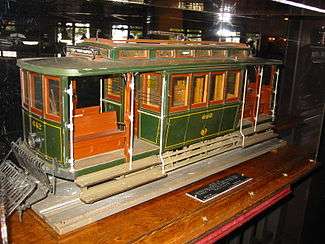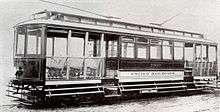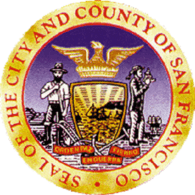Market Street Railway (transit operator)

The Market Street Railway Company was a commercial streetcar and bus operator in San Francisco. The company was named after the famous Market Street of that city, which formed the core of its transportation network. Over the years, the company was also known as the Market Street Railroad Company, the Market Street Cable Railway Company and the United Railroads of San Francisco.
The company should not be mistaken for the current Market Street Railway, which is named after its predecessor but is actually a legally unconnected non-profit support group for San Francisco's heritage streetcar lines.
History
The franchise for what would become the Market Street Railway was granted in 1857 to Thomas Hayes. The line was the first horsecar line to open in San Francisco, opened on July 4, 1860, as the Market Street Railroad Company.[2] A few years later, the line was converted to steam power utilizing a steam engine that was part locomotive and part passenger car, and a trailer car.[3]

Following the opening of the cable hauled Clay Street Hill Railroad in 1873, pressure grew to convert the city's horsecar lines to the new form of traction. In 1882, Leland Stanford and associates bought the Market Street Railroad Company and converted its lines to cable haulage. In the process, the company's name was changed to the Market Street Cable Railway Company. This company was to grow to become San Francisco's largest cable car operator. At its peak, it operated five lines all of which converged into Market Street to a common terminus at the Ferry Building; during rush hours a cable car left that terminus every 15 seconds.[2][4]
However transit technology was still moving on, and the new electric streetcar quickly proved to cheaper to build and operate than the cable car, and capable of climbing all but San Francisco's steepest hills. In 1893, Stanford died and the company was taken over by the Southern Pacific Railroad. The company was again renamed to the Market Street Railway Company, and began the process of converting its lines to electric traction. In 1895 the company placed a newspaper advertisement in the San Francisco Examiner offering horse cars for $20 ($10 without seats).[5] Many of these became the basis for the impromptu community built from streetcars called Carville-by-the-Sea.
Conversion to electricity was resisted by opponents who objected to what they saw as ugly overhead lines on the major thoroughfares of the city center. At 5:12 am on April 18, 1906, those objections were swept away as the great San Francisco earthquake struck. The race to rebuild the city allowed the company to replace all but the steepest of its cable car lines with electric streetcar lines.[2]

By this stage, the company had changed hands again, and become the United Railroads of San Francisco (URR). Over the years many independent lines had been absorbed, including the Clay Street Hill Railroad, the San Francisco and San Mateo Electric Railway, the Presidio & Ferries Railway, and the Ferries and Cliff House Railway. Ironically the earthquake that brought so many benefits to the company also sowed the seeds of its demise, as the independent Geary Street, Park & Ocean Railway was acquired by the city and became in 1912 the beginning of the San Francisco Municipal Railway (Muni). Horsecars were finally withdrawn from city streets on June 3, 1914.[6] By 1918, and assisted by the construction of several tunnels under the city's hills, Muni was in direct competition with the URR down the length of Market Street. The two operators each operated their own pair of rail tracks down that thoroughfare, which came to be known as the 'roar of the four'. The two Market Street Railway tracks were on the inside and the two San Francisco Municipal Railway tracks were on the outside.[2]
Competition, labor troubles and a bad accident in 1918 led to the reorganisation of the URR, to re-emerge again as the Market Street Railway Company. This continued to operate electric streetcars throughout the city, the Powell St. cable car lines, and a growing fleet of buses. But relations were not good with the city, who controlled their franchises, and on May 16, 1944, after defeating the proposal six times previously, voters elected to purchase the operative properties of the Market Street Railway for $7.5 million and the company sold all its assets and operations to Muni.[2]
Surviving vehicles
.jpg)

These are the only surviving vehicles from the Market Street Railway fleet.
- Car 578 was built in 1896 by Hammond Car Company. A single-truck (four-wheel), California-type car (open end sections, enclosed middle compartment). After serving many years as a work car, it was eventually restored to its original form by the Muni, and is still run for special events and charters.[7]
- Car 798 was built in the company's own shops in 1924. this car was sold for scrap after World War 2. Used as a residence and jewellery store in the California town of Columbia, it was reacquired in 1984 and is currently undergoing restoration for occasional use on the F Market line.[8]
See also
- San Francisco cable car system
- San Francisco Railway Museum
- San Francisco Municipal Railway
- Market Street Railway (nonprofit)
- San Francisco Municipal Railway fleet
References
- ↑ Smallwood, Charles The White Front Cars of San Francisco Glendale, California:1978 Interurban (Interurban Special #44) 600 Series Cars Page 203
- 1 2 3 4 5 Market Street Railway (2004). A Brief History of Market St. Railway. Retrieved September 23, 2005. Section The Market Street Railroad Company, 1860-1882 Archived September 21, 2005, at the Wayback Machine.
- ↑ Nolte, Carl (2010-07-04). "150th anniversary of first Market St.". The San Francisco Chronicle. San Francisco Chronicle. Retrieved 2010-07-04.
- ↑ Robert Callwell and Walter Rice (2000). Of Cables and Grips: The Cable Cars of San Francisco. Published by the Friends of the Cable Car Museum. ISBN unknown.
- ↑ San Francisco Examiner, September 22, 1895, pg. 19.
- ↑ "LAST HORSE CARS ARE DRIVEN BY ROLPH, CALHOUN". The San Francisco Examiner. 4 June 1913. Retrieved 12 June 2016.
- ↑ Market Street Railway. 1896 San Francisco MSRy car No. 578-S.
- ↑ Market Street Railway. 1924 San Francisco MSRy car No. 798
Further reading
- Smallwood, Charles The White Front Cars of San Francisco Glendale, California:1978 Interurban (Interurban Special #44) ISBN 978-0-916374-32-7--a complete history of the Market Street Railway company with numerous photos, illustrations and maps
